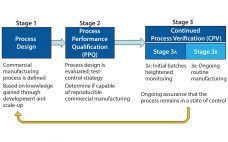As defined in the ICH Q10 guideline, a control strategy is “a planned set of controls, derived from current product and process understanding, that assures process performance and product quality” (1). Every biopharmaceutical manufacturing process has an associated control strategy. FDA’s 2011 guidance for process validation (2) describes process validation activities in three stages (Figure 1). A primary goal of stage 1 is to establish a strategy for process control that ensures a commercial process consistently produces acceptable quality products.…
Author Archives: Patrick Swann
Glycosylation of Therapeutic Proteins: Current Understanding of Structure–Function Relationships
A CMC Strategy Forum held in Washington, DC, on Sunday 28 January 2007 focused on two topics related to protein structure and function (1). First, analytical techniques used in the glycan analysis characterization included recent advances and correlations among the various tools. And second, current understanding of glycosylation’s functional relevance to therapeutic proteins was discussed in the context of its effects on biological activity, pharmacokinetics, and Fc effector functions (for monoclonal antibodies, MAbs). Progress has been made in the field…
Glycosylation of Therapeutic Proteins
ACMC Strategy Forum held in Washington, DC, on Sunday 28 January 2007, focused on two topics related to protein structure and function. First, analytical techniques used in the glycan analysis characterization included recent advances and correlations among the various tools. And second, current understanding glycosylation’s functional relevance to therapeutic proteins was discussed in the context of its effects on biological activity, pharmacokinetics, and Fc effector functions (for monoclonal antibodies, MAbs). Progress has been made in the field of…

